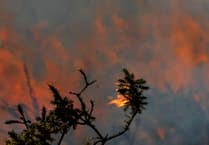HABITAT management and better summers in recent years have produced large numbers of beautiful and threatened orchids and damselflies on Dartmoor.
Dartmoor National Park (DNP) has been in a management agreement with the landowner of a cluster of haymeadows on the edge of Widecombe-in-the-Moor for more than 20 years now.
The fields were in urgent need of management, as no hay cut or grazing was taking place, and the flowers were beginning to disappear under thick grass, bracken and thorn bushes.
Now, sympathetic meadow management has been in place for a number of years and the fields have gone from strength to strength, with the density of bracken and scrub being much reduced, to the benefit of an array of flower species, including three orchid species.
Even more pleasingly, a new species of orchid appeared, or reappeared, in an area that had been cleared of thick blackthorn just two years previously — namely the Twayblade, a rare orchid species on Dartmoor.
A count carried out with the help of volunteers in June 2015 found that the three fields supported over 2,000 orchids of four different species.
The site was also alive with bees, including the rare mountain bumblebee, grasshoppers, moths and butterflies — all nectaring on the many flowers in these fields.
Record numbers of the very rare southern damselfly have been seen this year at all three of the sites where they are found in the national park.
Following the first locating of this insect here in 1995, it was subsequently found at another two sites after careful searches.
Since then, much habitat management has been undertaken by a combination of DNP staff, commoners, volunteers and contractors to produce conditions suitable for their long term survival and expansion in numbers.
Most notable this year has been a single day count of more than 300 damselflies at a site near Whiddon Down, where a management agreement between the farmer and DNP has been in place for 20 years.
The grazing of Dartmoor ponies and the use of volunteers has turned around the fortunes of this beautiful insect and its future on Dartmoor looks much more secure now than at any time since its discovery in the national park.
Norman Baldock, senior ecologist for Dartmoor National Park, said: ‘After so much hard work by volunteers and staff, it is great to see such fantastic numbers of these rare and precious species that have declined so rapidly in large parts of the countryside.’





Comments
This article has no comments yet. Be the first to leave a comment.